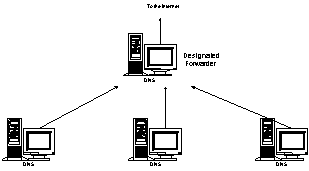
Use secondary servers as master servers when the primary is overloaded, or when there is a more efficient network path between "secondary to secondary" vs. "secondary to primary."
DNS servers store information about the domain name space and are referred to as name servers. Name servers generally have one or more zones for which they are responsible. The name server is then said to have authority for those zones.
When you configure a DNS name server (as we will soon see with the "NS" record), you tell it what are all of the other DNS name servers that are in the same domain.
A primary name server is a name server that gets the data for its zones from local files. Changes to a zone, such as adding domains or hosts, are done at the Primary Name Server. A secondary name server gets the data for its zones from another name server across the network which is authoritative for that zone. The processes of obtaining this zone information (that is the database file) across the network is referred to as a zone transfer.
There are three reasons to have secondary servers within an enterprise. Those reasons are:
Since information for each zone is stored in separate files, this primary or secondary designation is defined at a zone level. In other words, a particular name server may be a primary name server for certain zones and a secondary name server for other zones.
When defining a zone on a name server as a secondary, you must designate a name server from which to obtain the zone information. The source of zone information for a secondary name server in a DNS hierarchy is referred to as a master name server. A master name server can be either a primary or secondary name server for the requested zone. When a secondary name server starts up, it contacts its master name server and initiates a zone transfer with that server.
|
|
Use secondary servers as master servers when the primary is overloaded, or when there is a more efficient network path between "secondary to secondary" vs. "secondary to primary." |
When a DNS name server receives a DNS request, it attempts to locate the requested information within its own zone files. If this fails because the server is not authoritative for the domain requested, it must communicate with other DNS name servers to resolve the request. Since, on a globally connected network, a DNS resolution request outside a local zone typically requires interaction with DNS name servers outside of the company on the public Internet, you may want to selectively enable specific DNS name servers in your company to do this wide-area communication.
To address this issue, DNS allows for the concept of forwarders. Specific DNS name servers are selected to be forwarders, and only forwarders are allowed to carry out the wide-area communications across the Internet. All other DNS name servers within the company are configured to use forwarders and are configured with the IP addresses of the DNS name servers designated as forwarders. This configuration is done on a per server basis, not a per zone basis!

When a server which is configured to use forwarders receives a DNS request that it is unable to resolve (through its own zone files), it passes the request to one of the designated forwarders. The forwarder then carries out whatever communication is necessary to resolve the request and returns the results to the requesting server, which, in turn, returns the results to the original requester. If the forwarder is unable to resolve the query, the DNS server attempts to resolve the query on its own as normal.
Slaves are DNS servers that have been configured to use forwarders and have also been configured to return a failure message if the forwarder is unable to resolve the request. Slaves make no attempt to contact other name servers if the forwarder is unable to satisfy the request.
Although all DNS name servers cache queries that they have resolved, Caching-only servers are DNS name servers whose only job is to perform queries, cache the answers, and return the results. In other words, they are not authoritative for any domains and only contain information which they have cached while resolving queries.
When trying to determine when to use such a server, keep in mind that when the server is initially started it has no cached information and must build up this information over time as it services requests. However, if you are dealing with a slow link between sites then there is much less traffic sent across the slow link because the server is not doing a zone transfer.